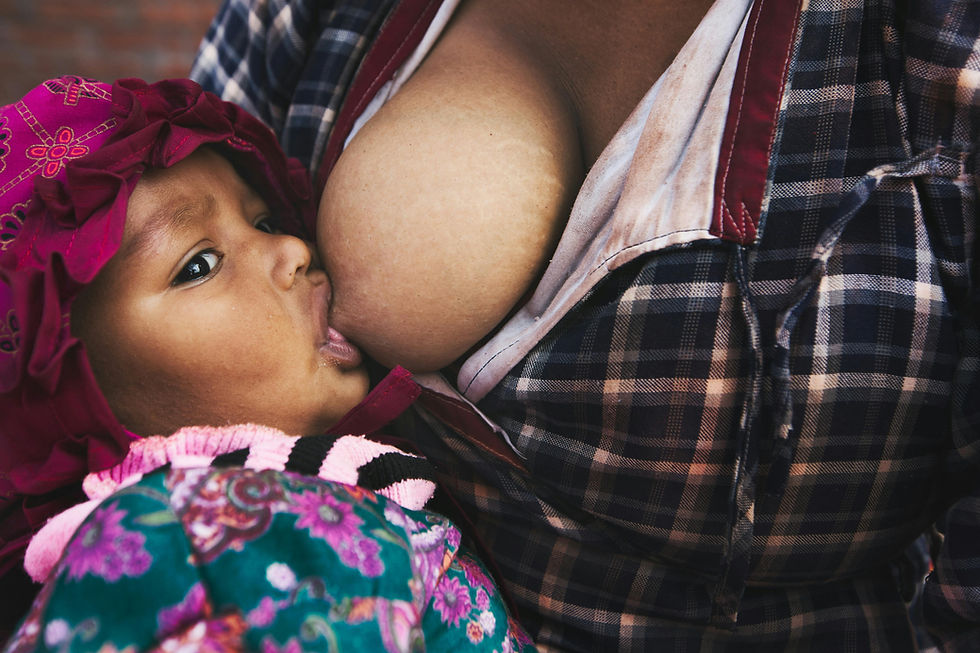The Gut-Mammary Transfer Hypothesis: How Maternal Microbes Shape Infant Health Through Breastfeeding
- thebloominggut
- Apr 30
- 2 min read
The gut-mammary transfer hypothesis—also called the entero-mammary pathway—suggests that some of the good bacteria from a mother’s gut can travel to her breasts while she’s breastfeeding.
These bacteria then become part of her breast milk.
When her baby drinks the milk, the bacteria help build the baby’s gut microbiome—the community of microbes that live in the digestive system. This early exposure is important for the baby’s immune system to grow and function properly.
This idea shows how deeply connected a mother’s and baby’s health really are. It reminds us that breastfeeding does more than feed a baby—it also helps shape their long-term health.

How a Mother's Gut Bacteria Support Her Baby's Health Through Breastfeeding
Breastfeeding is more than just a way to nourish a baby; it's a means through which a mother can pass beneficial bacteria from her own body to her infant. This process, known as the gut-mammary transfer, involves the movement of helpful microbes from the mother's digestive system to her breast milk, aiding in the establishment of the baby's gut microbiome.
How Does This Transfer Happen?
Translocation of Bacteria: Beneficial bacteria from the mother's gut can cross the intestinal lining into her bloodstream or lymphatic system.
Migration to Mammary Glands: These bacteria travel to the mammary glands, becoming part of the breast milk's microbial community.
Role of Immune Cells: Immune cells like dendritic cells and macrophages can carry these bacteria from the gut to the breast tissue.
Ingestion by the Infant: When the baby breastfeeds, they ingest these beneficial microbes, which help colonize their gut.
Evidence Supporting This Process
Shared Bacteria: Studies have found that specific gut-associated bacteria, such as Faecalibacterium and Roseburia, are present in maternal feces, breast milk, and the infant's feces, indicating a direct transfer.
Timing of Transfer: Research involving mother–child pairs showed that bacteria like Faecalibacterium, Blautia, and Lachnoclostridium are transferred during different lactation periods, especially during the early colostrum phase.
Immune Cell Involvement: B-lymphocytes, a type of immune cell, can move from the maternal gut to the mammary gland, producing IgA antibodies that are secreted into breast milk, providing immunological protection to the infant.
Why Is This Important for the Baby?
Immune System Development: The introduction of maternal microbes helps the baby's immune system mature and learn to distinguish between harmless and harmful substances.
Disease Protection: A well-established gut microbiota in infants is linked to a reduced risk of conditions like allergies, asthma, and autoimmune diseases.
Potential for Probiotic Use: Understanding this transfer opens possibilities for maternal probiotic supplementation during pregnancy and lactation to enhance the beneficial microbial composition of breast milk.
The gut-mammary transfer highlights the intricate connection between a mother's microbiota and her infant's developing gut ecosystem. This natural process not only aids in the initial colonisation of the infant gut but also plays a crucial role in shaping the immune system and overall health of the newborn. Ongoing research is essential to fully understand these mechanisms and to develop strategies that support maternal and infant health.
Sources:
Vertical Transfer of Gut-Associated Anaerobes
Lactation-Dependent Transmission
https://pubs.rsc.org/en/content/articlehtml/2022/fo/d1fo03131g
Role of Immune Cells
https://translational-medicine.biomedcentral.com/articles/10.1186/s12967-023-04656-9
Potential for Probiotic Interventions




Comments